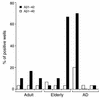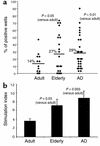Increased T cell reactivity to amyloid beta protein in older humans and patients with Alzheimer disease
- PMID: 12897209
- PMCID: PMC166296
- DOI: 10.1172/JCI18104
Increased T cell reactivity to amyloid beta protein in older humans and patients with Alzheimer disease
Abstract
Alzheimer disease (AD) is characterized by the progressive deposition of the 42-residue amyloid beta protein (Abeta) in brain regions serving memory and cognition. In animal models of AD, immunization with Abeta results in the clearance of Abeta deposits from the brain. However, a trial of vaccination with synthetic human Abeta1-42 in AD resulted in the development of meningoencephalitis in some patients. We measured cellular immune responses to Abeta in middle-aged and elderly healthy subjects and in patients with AD. A significantly higher proportion of healthy elderly subjects and patients with AD had strong Abeta-reactive T cell responses than occurred in middle-aged adults. The immunodominant Abeta epitopes in humans resided in amino acids 16-33. Epitope mapping enabled the identification of MHC/T cell receptor (TCR) contact residues. The occurrence of intrinsic T cell reactivity to the self-antigen Abeta in humans has implications for the design of Abeta vaccines, may itself be linked to AD susceptibility and course, and appears to be associated with the aging process.
Figures




Comment in
-
Amyloid beta and Alzheimer disease therapeutics: the devil may be in the details.J Clin Invest. 2003 Aug;112(3):321-3. doi: 10.1172/JCI19420. J Clin Invest. 2003. PMID: 12897198 Free PMC article.
References
-
- Price DL, Sisodia SS. Mutant genes in familial Alzheimer’s disease and transgenic models. Annu. Rev. Neurosci. 1998;21:479–505. - PubMed
-
- Selkoe DJ. Alzheimer’s disease: genes, proteins, and therapy. Physiol. Rev. 2001;81:741–766. - PubMed
-
- Jarrett JT, Lansbury PT., Jr Seeding “one-dimensional crystallization” of amyloid: a pathogenic mechanism in Alzheimer’s disease and scrapie? Cell. 1993;73:1055–1058. - PubMed
-
- McGeer EG, McGeer PL. The importance of inflammatory mechanisms in Alzheimer disease. Exp. Gerontol. 1998;33:371–378. - PubMed
Publication types
MeSH terms
Substances
LinkOut - more resources
Full Text Sources
Other Literature Sources
Medical
Research Materials

